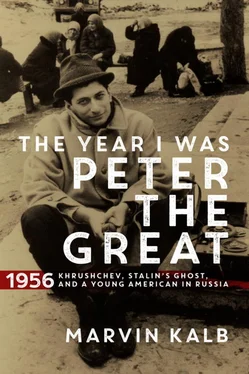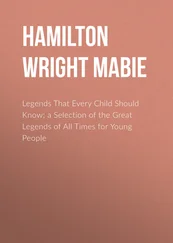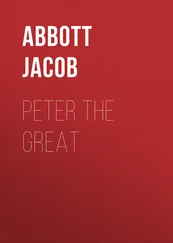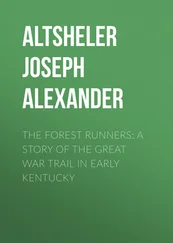The ride to Mtskheta was instructive. Farmhouses dotted the landscape. If there were any collective farms in the neighborhood, I did not see them. Fat, healthy-looking cows mooed as we drove by. In Mtskheta we could see clouds hugging the mountain peaks, a gray mist making everything look unreal. A large church, the largest I had ever seen in the Soviet Union, stood incongruously on a small square in this very quiet town. The church was built in the eleventh century on the ruins of a smaller church built in the fourth century. Mtskheta was Christianized in A.D. 337, almost 700 years before Prince Vladimir of Kievan Rus decided to Christianize the people who would later be known as Ukrainians and Russians. In the smaller church was an icon of Christ, brought there by Georgian pilgrims who had returned from the Holy Land centuries earlier. Another icon, hanging on a bare wall, showed Christ’s eyes watching you at all times, no matter where you were in the church. I could not help but notice that the icons in Mtskheta were more beautiful, more sophisticated than any of the Russian icons I had seen (at least until Andrei Rublev arrived on the artistic scene in the fifteenth century).
Mtskheta was the capital of Georgia for 300 years, but in the fifth century, after it was leveled and many of its citizens massacred, it was decided, for reasons of security, to move the capital to nearby Tbilisi, which has remained the capital ever since. Tbilisi has always been considered a jewel of a city, a rich marketplace at an attractive intersection between Asia and Europe and a strategic hub for warriors from Mongolia, Persia, Russia, and the Ottoman Empire, at different times a prize for Tamerlane, a Persian shah, or a Russian czar. Looking around on that rainy day I could understand why. It was indeed a jewel, measured by everything from location to scenery, culture to art, beauty to people—most of all, people, who strode through their history with unparalleled pride. I asked a Georgian professor whether he had ever been to Western Europe, or China, or America, and he said no, adding with bewilderment, “What is there to see there that isn’t better here?”
After a lunch of veal shashlik accompanied by Georgian wine, my new photographer friend and I visited the Chavchavadze Desyatilyetka ( desyatilyetka means “ten-year school,” mandatory for all Soviet students). Wherever I went in the Soviet Union I always tried to spend a little time at schools with students. Since they represented the future of their country, I wanted to understand their thinking.
There were 1,000 students in this school, half at the elementary and half at the secondary school level. Roughly 250 students had been graduated the previous year. Half of the graduates went on to university, the other half directly into the workplace. All classes were conducted in the Georgian language, but everyone had to study Russian eight hours a week.
We spoke to the principal, an attractive Georgian woman who spoke Russian with a distinct accent. She was especially absorbed with the educational mandate of the 20th Party Congress: to place greater emphasis on teaching technical subjects without lowering overall academic standards. “This is part of our desire to raise the technical proficiency of our youth,” she explained. Khrushchev wanted more engineers and physicists, and this was his way of achieving that goal. I had read about another new goal—increasing the number of boarding schools.
“Will the Chavchavadze Desyatilyetka be one of the new boarding schools?” I asked.
She replied, “Not likely”—there was no room for expansion. But she was nevertheless convinced that within ten years all Soviet schoolchildren would be housed in boarding schools. Already 285 such schools had been opened in the last year. In four years, by 1960, she estimated, the number would theoretically skyrocket to 1 million boarding schools. The Kremlin’s point was to indoctrinate young people with a communist-centric view of the world. That had not yet been achieved, and my own guess was it never would be.
“Would you like to see our classrooms?” the principal asked.
“Yes, of course,” we said.
The classrooms were clean, and every one had a large photo of Stalin (the offices, too). Stalin looked young, vigorous, intelligent, and even handsome, like a Hollywood movie star. The latest school newspaper, a weekly, featured a photo of Stalin on its front page, even though there was no news-related reason to put one there. Beneath the photo was a poem about freedom that Stalin had supposedly written when he studied religion at a Tbilisi seminary (a building that was later converted into the Georgian State Museum). Stalin was born in 1878 in a village called Gory. His mother was a hardworking housekeeper, and his father was a drunk who often beat his wife. Stalin was a bright, promising student who one day might have become a priest—that was his mother’s dream—if it were not for his after-hours dedication to the rising revolutionary currents then sweeping through the Russian Empire. His seminary teachers kept warning him that he would be expelled if he did not stop his subversive activity, but Stalin either could not or would not stop, and he was soon expelled, much to his mother’s distress. From then on, Stalin devoted himself to Lenin’s revolution, ultimately riding his coattails to absolute power in the Kremlin.
Intourist must have alerted the Georgian State Museum of my impending visit, because a small team of docents backed by two MVD officers was waiting for me. “Welcome,” said one of the docents, an elderly man with a V-shaped beard and an elaborately etched cane. “We have something special for you.” Much to my surprise, he and the officers led me to a locked room in the basement, which when the doors opened proved to be a treasure chest of Georgian icons. I had never seen a collection so enchanting anywhere. The icons, crafted in Georgia, dated back to the seventh and eighth centuries, graphic evidence of a once-flourishing civilization. When we got to examples from the thirteenth and fourteenth centuries, the quality of the icons seemed mysteriously to dip. The docent, sensing my unasked question, explained the dip with one word: “Mongols.” There was one other noticeable dip in quality. This time I could figure out the reason myself. When the Russians seized Tbilisi in the early nineteenth century, the Georgian craftsmen “lost” their creative passion.
I had one more question for the docent. “Why did you bring me here?”
He smiled broadly. “Three years ago Ambassador Bohlen visited our museum. He identified part of one icon we have here as the sister part of an icon in the United States. He was very excited, and so were we.” He leaned on his cane. “You see,” he went on, “we are now brother and sister.” When he learned that a visiting American diplomat wanted to see the Georgian State Museum, he remembered the Bohlen visit. I was the lucky beneficiary. I got to see this exceptional collection of Georgian art. The docent told me, his voice filled with pride, that a new generation of Georgian artists was studying this ancient art and hoping in this way to recapture the greatness of the Georgian renaissance, which he placed in the tenth through twelfth centuries. “That’s two hundred years before the Italian renaissance,” he noted with a broad smile.
After my visit to the museum I asked my Intourist guide if I could walk back to the hotel alone, and, miracle of miracles, he said yes. The guide went one way, and I another. I knew what was going to happen. Within a few minutes, I was positive, a young Georgian student would engage me in conversation, and so it happened. He was, like most other Georgian students, relatively tall and well dressed, and he had a thick mustache. He was a student at the Pedagogical Institute, and he had a special interest in America. He said someone at the hotel had told him an American was in town. “I was following you, waiting for you to be alone,” he said in good English. He did not give me his name, but in every other respect he seemed to be uninhibited. We sat down on a park bench, and we talked, and talked, and talked.
Читать дальше












